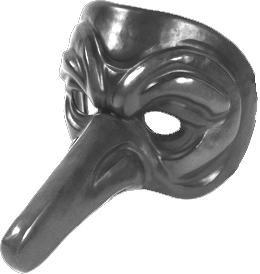Imagine yourself transported to the bustling piazzas of 16th-century Italy. Jugglers tumble, musicians serenade, and a troupe of masked figures weave through the crowd, their exaggerated features and vibrant costumes drawing curious onlookers. This wasn’t scripted entertainment; it was Commedia dell’Arte, a form of improvisational street theatre that continues to influence theatre today.
While the origin of Commedia masks is unclear, their roots likely lie in ancient Roman mime, Etruscan rituals, and medieval folk festivals. Early masks, crafted from sturdy leather, showcased exaggerated features that identified stock characters and social types. From the hooked nose of the cunning Zanni to the smirk of the pretentious Dottore, each mask served as a visual shorthand, instantly communicating a character’s personality and comedic potential.
A Pantheon of Personalities



The diverse cast of Commedia characters, each defined by their unique mask, transcended individual actors and resonated across centuries. Here’s are some of the most renowned:
Servants
- Zanni: The mischievous servant, often depicted with a long nose and wide grin, embodied cunning and trickery. He had several variations, each with distinct quirks: the quick-witted Servetta Zannetta, the acrobatic Zanni Mezzetti, and the sly Brighella with his black glasses and patched costume.
- Arlecchino: The patchwork harlequin, a symbol of chaos and playful trickery, was instantly recognizable by his diamond-patterned suit and mischievous grin. His acrobatic agility and playful demeanor made him a crowd favorite.
- Pulcinella: The hunchbacked Neapolitan servant, characterized by a beaked nose, beaked mask, and raspy voice, represented wit and resourcefulness. His origins are debated, with some tracing him back to Roman Pulcinellae, mischievous puppet figures.
Masters
- Pantalone: The greedy Venetian merchant, identified by his hooked nose, spectacles, and baggy trousers, personified miserliness and foolishness. His name might derive from “pianta leone,” meaning “plant the lion,” a symbol of Venice.
- Dottore: The pompous doctor, portrayed with a beaked nose, flowing beard, and spectacles, represented gullibility and pretentiousness. His garbled Latin and nonsensical diagnoses were a constant source of comedic fodder.
- Capitano: The boastful soldier, distinguished by his feathered mask and exaggerated swagger, embodied cowardice and empty pride. His braggadocio and inflated sense of honor made him a target for playful ridicule.
Lovers
- Innamorati: The young, idealistic lovers, typically unmasked, represented by their elegant costumes and romantic demeanor. Their innocence and naiveté provided a sweet counterpoint to the chaotic antics of the masked characters.
Lazzi: comedy routines
“Lazzi” (singular: “lazzo”) are improvised comedic routines or gags commonly used in Commedia dell’Arte. These routines were essential elements of the performance, adding spontaneity, humor, and variety to the show.
The term “lazzo” is derived from the Italian word “laccio,” meaning “tie” or “bond,” suggesting the tight structure and interconnectedness of these comedic interludes within the overall performance. Lazzi involved physical comedy, wordplay, slapstick, or absurd situations, that the stock characters had to find their way out of. These routines were often social satire.
Lazzi could be performed by individual characters or involve interaction between multiple characters. They were typically repeated throughout different performances but were often adapted and modified by actors to suit the specific context or audience reaction.
These comedic interludes served multiple purposes within the framework of Commedia dell’Arte performances:
- Entertainment: Lazzi were meant to entertain the audience and provide moments of levity amidst the main plotline. They often showcased the physical prowess and comedic timing of the actors.
- Improvisation: Commedia dell’Arte performances were highly improvisational, and lazzi allowed actors to showcase their improvisational skills. They could be inserted into the performance on the spot, responding to audience reactions or unforeseen circumstances.
- Characterization: Lazzi were often tailored to the specific traits and characteristics of the stock characters in Commedia dell’Arte. They helped reinforce the audience’s understanding of each character’s personality and quirks.
- Audience Engagement: Lazzi were interactive and could involve direct engagement with the audience. This engagement heightened the sense of participation and involvement in the performance.
The Actor Training Potential of Masks
More than just decorative props, Commedia masks serve as powerful tools for actor training. By wearing the masks, actors shed their own inhibitions and unlock a wellspring of comedic timing, exaggerated gestures, and heightened emotions. Here’s how these masks empower actors:
- Physical Expression: The exaggerated features of the masks demand exaggerated physicality. Actors learn to communicate emotions through posture, gait, and movement, honing their non-verbal communication skills.
- Vocal Projection: Unable to rely on facial expressions, actors project their voices clearly and expressively, developing strong vocal techniques and stage presence.
- Improvisation: Commedia relied heavily on improvisation, and masks encouraged actors to be present in the moment, adapt to their scene partners, and think on their feet.
This unique training method has influenced countless theatre legends, from Molière and Carlo Goldoni, to even Charlie Chaplin. The legacy of Commedia masks extends beyond the Italian stage, enriching contemporary acting techniques and reminding us of the power of physical expression and improvisation.
Craftsmanship
The iconic Commedia masks weren’t simply mass-produced props; they were works of art, meticulously crafted by skilled artisans. Renowned families like the Ca’ Maccari in Venice and Fratelli Guerra in Naples became synonymous with mask-making excellence, passing down their techniques and artistic interpretations through generations. Their legacy lives on in workshops across Italy.
Where to Learn More
The story of Commedia dell’Arte masks is one of vibrant culture, historical echoes, and artistic ingenuity. If you’re curious to delve deeper, here are some resources:
Theatre Organizations:
- Commedia dell’Arte International Foundation: https://dellarte.com/
- Scuola Internazionale dell’Attore Comico: http://www.antoniofava.com/en/
- The National Centre for Commedia dell’Arte: http://www.charioteertheatre.co.uk/education/academy/
Online Resources:
- The Commedia dell’Arte Resource Center: https://homunculustheatre.com.au/wp-content/uploads/2016/07/Commedia-101.pdf
- The Commedia dell’Arte Wikipedia article: https://en.wikipedia.org/wiki/Commedia_dell%27arte
- Maskmaking Tutorial: https://www.youtube.com/watch?v=OwCNmWKHCLU

